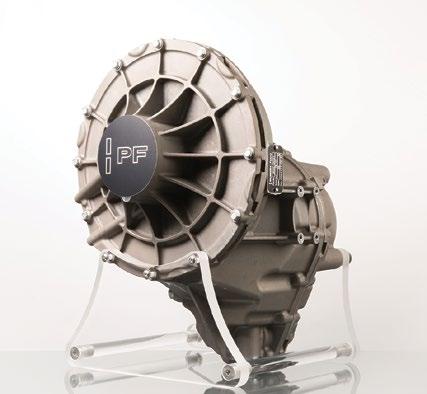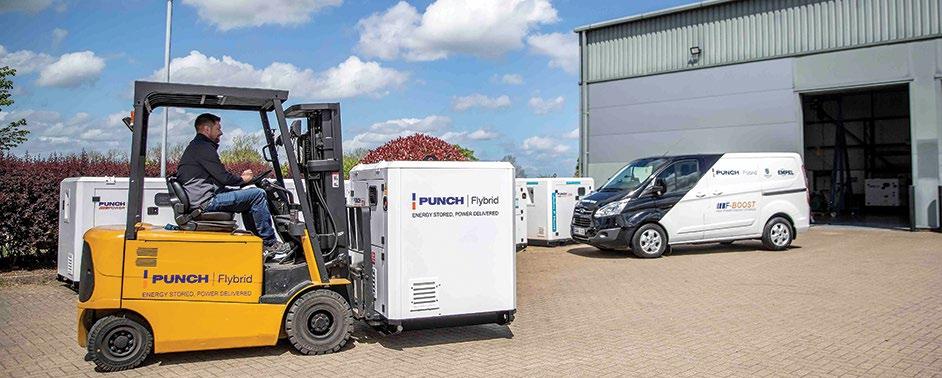
9 minute read
Flywheel technology is a game changer
Flywheel technology is a game changer
New game changing flywheel technology developed by UK company PUNCH Flybrid is helping some pioneering contractors drastically reduce carbon emissions and costs when running big electric powered equipment such as tower cranes, hoists and mastclimbers.

Construction and development group Bowmer + Kirkland was the first construction company to recognise the potential of the new technology - which has its roots in Formula 1 - and the first to install two PUNCH Power 200 machines on site resulting in massive cost and emission savings with its tower cranes and then mastclimbers. Bowmer + Kirkland now has more than 10 Power 200s and is at the forefront of reducing carbon emissions from the equipment it uses. Going forward it plans to use them on all its sites with tower cranes, hoists and mastclimbers, an approach that is helping to save the environment and support new technology which will benefit the entire construction and perhaps other industries.


What is flybrid technology?
Tobias Knichel, managing director of Silverstone based PUNCH Flybrid explains: “Dynamic duty cycles waste a great deal of energy because they require a lot of power for short periods of time, as a result this type of application has traditionally required oversized powertrains purely to cope with the peak demand.”
“But what if the power source - a generator, battery or mains electric power for examplecould draw on an external power source to deliver that peak dynamic load, injecting energy only when the large power demand is required e.g. when a crane lifts a heavy load at maximum speed or when a Formula 1 car needs full power when accelerating? A short surge of power from an outside source when needed would allow the size of the generator powering the equipment to be matched to the average load - when slewing or lifting lighter loads - thus saving fuel and reducing emissions. This is exactly what the PUNCH Flybrid Power 200 does.”
As we have already mentioned the system was originally developed for motor sport because a race car is constantly switching between full acceleration or hard braking and so has a very dynamic duty cycle. There are however many other types of equipment with similar dynamic duty cycles such as excavators and wind turbines but also compressors as well as tower cranes and mastclimbers. In trials carried out by Bowmer + Kirkland over the past year or so, it has found that it was able to cut the size of generator used to run a tower crane by more than half, from a typical 300kVA to 100kVA, reducing the rental cost of the generator as well as saving massive amounts of fuel because the fuel efficiency of a smaller generator running at a more constant load - thanks to the Flybrid flywheel technologyis drastically more efficient than a big generator having to cope with the fluctuating demand from the duty cycle work of a busy crane. how does it work?
PUNCH Flybrid uses a flywheel energy storage system - essentially a highly engineered flywheel which can spin at high speeds - connected to a combined electric motor/generator which powers the flywheel during periods of lower demand and then converts to a generator driven by the flywheel when the crane needs more power. This running gear is then enclosed in a protective, ventilated, skid mounted generator like case measuring 1.2 x 1.6 x 1.5 metres and weighing about 500kg to create the PUNCH Power 200. This is then simply plugged in between the power source - a diesel or hydrogen genset, battery or mains power - and the tower crane or mastclimber. Maintenance is minimal requiring just an annual oil and filter service plus bearing greasing once every year.



Inside the Power 200 the energy is stored as kinetic energy in the spinning flywheel, and this is transferred by the motor/generator to the crane when it needs that short burst of power. When the tower crane is about to lift a load and spike the power requirement, the Power 200 reacts to the frequency and voltage changes between the power source and application and uses the energy stored in the flywheel to generate the extra power to cover the crane’s surge requirement, eliminating the additional demand on the generator. This allows the generator to run at almost constant load, rather than forever changing to cope with the vastly differing power requirement of the tower crane. The Power 200 works whatever the power supply/source and is literally ‘plug and play’.
There is only size of one Flybrid unit available - the Power 200 - but this can cope with generators from 100kVA to 1000kVA. If more power is involved then it is possible to connect the Power 200s together to deal with 2000, 3000, 4000kVA etc if required.
There are many examples which we will cover in detail later however here is just one simple example of the substantial savings on a typical tower crane application. The usual 300kVA generator supplying the crane was consuming about 8.3 litres of diesel an hour, largely because it had to deal with frequent changes in power requirements. After installing the Flybrid system and replacing the larger generator with a smaller one, fuel consumption was reduced to just 3.3 litres an hour for exactly the same work! On a tower crane that might be on site 75 weeks that is a huge saving in diesel, genset rental and CO2 emissions. The financial saving was substantial a year ago, but with the current cost of diesel it is staggering.

PUNCH Power 200s are manufactured in the UK using conventional materials and processes resulting in fewer supply chain issues. They are easy to recycle and have very low full life-cycle emissions in the manufacture, usage and recycling phases.

“With the global energy crisis, we are heading into a period where it will become more and more unacceptable to waste energy,” says Knichel. “Bowmer + Kirkland was one of the first companies we worked within the construction sector that was prepared to try this new technology with its tower cranes.”
“The starting power required is generally significantly higher than the running power. One of the first crane applications was on a luffing crane which would normally be powered by a 325kVA generator set - in this case it was an Atlas Copco QAS 325 with 325/260 kVA/kW power. After installing the PUNCH Power 200 the generator was reduced to a 100kVA HGI HRD 1000T with 100/80 kVA/kW reducing the genset by a factor of 3.25 saving more than 51 percent of the fuel which equates to saving more than 240 litres of fuel per week and more than 12,000 litres per year. The annual emissions saved is more than 32 tonnes of CO2 which is the same level of emissions as 21 cars driving an average annual mileage of 7,400 miles.”

Another example involved a 66 tonne Terex CTL 1600-66 luffing tower crane which had its 800kVA genset downsized by a factor of 2.5 to 320kVA after installing a PUNCH Power 200. Savings of more than 633 litres of fuel per week/31,000 litres per year and more than 83 tonnes of CO2 per year - or the equivalent of 55 cars - were achieved.
Mega hoist savings
“Hoists are typically powered by Direct on Line (DOL) motors which start at full load drawing a large amount of current and a significant challenge to genset frequency and voltage stability. Trials were carried out on a UK site with two Alimak Scando 650 hoists each normally powered by 200kVA genset. By adding a PUNCH Power 200 it was possible to downsize to just a single 100kVA genset for both hoists. Thus, a fourfold reduction resulted in a fuel saving of 71 percent!”
The use of the Flybrid technology in the Power 200s also allows more equipment to be powered by an existing AC mains connection, avoiding the use of additional diesel generators to help the site cope when the mains connection is not large enough to power the application. It also minimises the cost and time of upgrades for site power requirements and there is also a cable sizing and connection switchgear size/ cost reduction. And on certain sites the diesel generators can be removed altogether after employing the flywheel power system.

At the moment the company is producing around 10 Power 200s a week and each is available for purchase at a fixed cost of £44,900. Many have been sold to rental companiessuch as John F Hunt Power - which are now available to rent. Tower crane rental companies may also be able to supply one with the crane. This really is a game changing product.
PUNCH Flybrid’s flywheel technology and Bowmer + Kirkland have recently been recognised in the British Construction Industry Awards winning the ‘Carbon Net Zero Initiative of the Year’ award as well as the overall ‘Initiative of the Year’ award - chosen from all the category winners. And it’s easy to see why. It is a win, win, win product where everyone gains. ■











